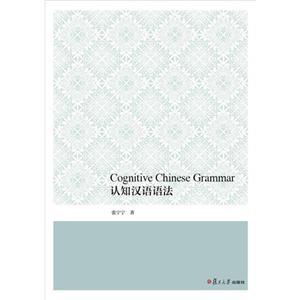-
>
心灵元气社
-
>
县中的孩子 中国县域教育生态
-
>
(精)人类的明天(八品)
-
>
厌女(增订本)
-
>
这样学习才高效/杨慧琴
-
>
心理学经典文丛:女性心理学
-
>
中国文化5000年
认知汉语语法 版权信息
- ISBN:9787309114249
- 条形码:9787309114249 ; 978-7-309-11424-9
- 装帧:一般胶版纸
- 册数:暂无
- 重量:暂无
- 所属分类:>
认知汉语语法 本书特色
《cognitive chinese grammar认知汉语语法》协调了认知语言学中的隐喻、转喻、范畴化、概念整合、词汇压制、认知语法、认知语义学、认知词汇学等等理论,建立了一个适合全面分析自然语言现象(不仅仅是汉语现象)的理论框架,并将其运用于分析(部分)汉语语法现象。《cognitive chinese grammar认知汉语语法》企图说明:(1)汉语语法并不“特殊”,完全可以用认知和语言的一般规律来描写和解释;(2)汉语的句法结构并不象有些学者认为的那样“灵活”,而句法—词汇融合上的限制同样也可以用认知规律来解释;(3)一种语言现象背后往往存在好几种认知因素,“非此即彼”的结论存在很大风险,“综合”式的解释才符合语言和思维规律。
认知汉语语法 内容简介
《Cognitive Chinese Grammar认知汉语语法》协调了认知语言学中的隐喻、转喻、范畴化、概念整合、词汇压制、认知语法、认知语义学、认知词汇学等等理论,建立了一个适合全面分析自然语言现象(不仅仅是汉语现象)的理论框架,并将其运用于分析(部分)汉语语法现象。《Cognitive Chinese Grammar认知汉语语法》企图说明:(1)汉语语法并不“特殊”,完全可以用认知和语言的一般规律来描写和解释;(2)汉语的句法结构并不象有些学者认为的那样“灵活”,而句法—词汇融合上的限制同样也可以用认知规律来解释;(3)一种语言现象背后往往存在好几种认知因素,“非此即彼”的结论存在很大风险,“综合”式的解释才符合语言和思维规律。
认知汉语语法 目录
preface
chapter one introduction
chapter two cognitive chinese grammar: a framework
1.cognitive resources
2.a cognitive—linguistic perspective on grammar
3.academic labeling
4.implicit and explicit linguistic knowledge
chapter three instruments as objects
1.introduction
2.definition of instrument
3.constraints on instrument objects
4.summary
chapter four the unlikely objects of 吃(chī)
1.introduction
2.a classification of吃+object combinations
3.the semantic network of吃
4.the productivity of the 吃+object construction
5.summary and discussion
chapter five the bǎ(把)—construction
1.introduction
2.previous studies
3.an anatomy of the bǎ—construction
4.the semantic characteristics of the main verb
5.the semantic characteristics of the pre—posed object
6.the many faces of the result element
7.the semantic characteristics of the subject
8.anomalous instances of the bǎ—construction
9.the bǎ—construction and the shǐ(使)—construction in
comparison and contrast
10.summary and discussion
chapter six resultative constructions
1.introduction
2.conceptual motivations
3.the make—up of verb—result structures
4.the verb—copying resultative construction
5.the de(得)—resultative construction
6.directional lexemes as result elements
7.inversion in resultatives
8.summary
chapter seven the double—object construction
1.introduction: settling the dust
2.the double—object schema and its constructional meaning
3.the semantics of the verb
4.the curious case of the“np1+v+他+(numeral)np2”
template
5.pseudo—double—object structures
6.summary
chapter eight the existential construction
1.introduction: issues and non—issues
2.the chinese existential construction: an anatomy
3.the locative np
4.the predicate verb
5.the locatum np
6.the disappearance—emergence construction
7.summary and discussion
chapter nine nominal predicates
1.introduction
2.patterns with nominal predicates
3.cognitive operations behind nominal—predicate templates
4.“inherently predicative”nps and pattern(e)
5.nouns functioning as adjectives
6.summary and discussion
chapter ten the double—subject construction
1.introduction: a delimitation
2.aligning the base and the profile
3.other double—subject constructions
4.summary
chapter eleven the bèi(被)—construction
1.introduction
2.the bèi—construction,a sketch
3.the patient—subject
4.the nature of the agent np and the predicate
5.the newfangled bèi—schema
6.summary
chapter twelve conclusion and prospectus
references
- >
二体千字文
二体千字文
¥14.0¥40.0 - >
罗曼·罗兰读书随笔-精装
罗曼·罗兰读书随笔-精装
¥24.9¥58.0 - >
姑妈的宝刀
姑妈的宝刀
¥9.6¥30.0 - >
【精装绘本】画给孩子的中国神话
【精装绘本】画给孩子的中国神话
¥17.6¥55.0 - >
小考拉的故事-套装共3册
小考拉的故事-套装共3册
¥36.7¥68.0 - >
苦雨斋序跋文-周作人自编集
苦雨斋序跋文-周作人自编集
¥6.9¥16.0 - >
罗庸西南联大授课录
罗庸西南联大授课录
¥13.8¥32.0 - >
随园食单
随园食单
¥24.0¥48.0
-
字海探源
¥25¥78 -
《标点符号用法》解读
¥8.3¥15 -
文言津逮
¥10.2¥28 -
那时的大学
¥12¥28 -
现代汉语通用字笔顺规范
¥19.6¥58 -
2020年《咬文嚼字》合订本
¥23.8¥60


















